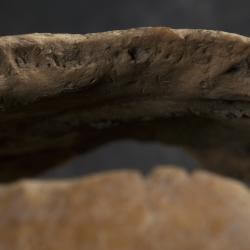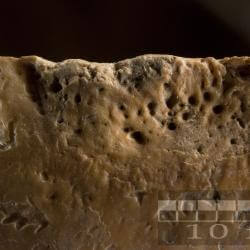Trepanation is one of the most ancient surgical interventions, which is known from several cultures across the world; however, they can be different according to the applied technique. Trepanation cases are mostly from cemeteries of the Hungarian conquest period (9-10th c.) but there are examples from the previous Avar period as well. At Baracs-Szitány dűlő during the construction work of the M8 motorway in 2008 (site director: Kálmán Csaba Kiss), a grave was found which is an evidence for that this intervention was carried out even on children if it was necessary.
Among the eleven individuals found in the Avar graves (7-8th c.), there was a 7-9 year-old child with a large ‘plum-stone’-shaped opening on the right parietal bone which was performed by a sharp object.
The size, shape and the morphology of the edges of the large opening indicate that it was created through an intentional operation, probably as a result of surgical trepanation. However, the bone structural changes at the edges of the wound suggest healing which means that the child had survived the surgery, yet the cause of death can be due to to this treatment. Why? You can find out in the next post of this story soon...
Orsolya László
The results of anthropological analysis can be accessed in the Archaeology Database under Archaeometry: http://archeodatabase.hnm.hu/en/node/711


